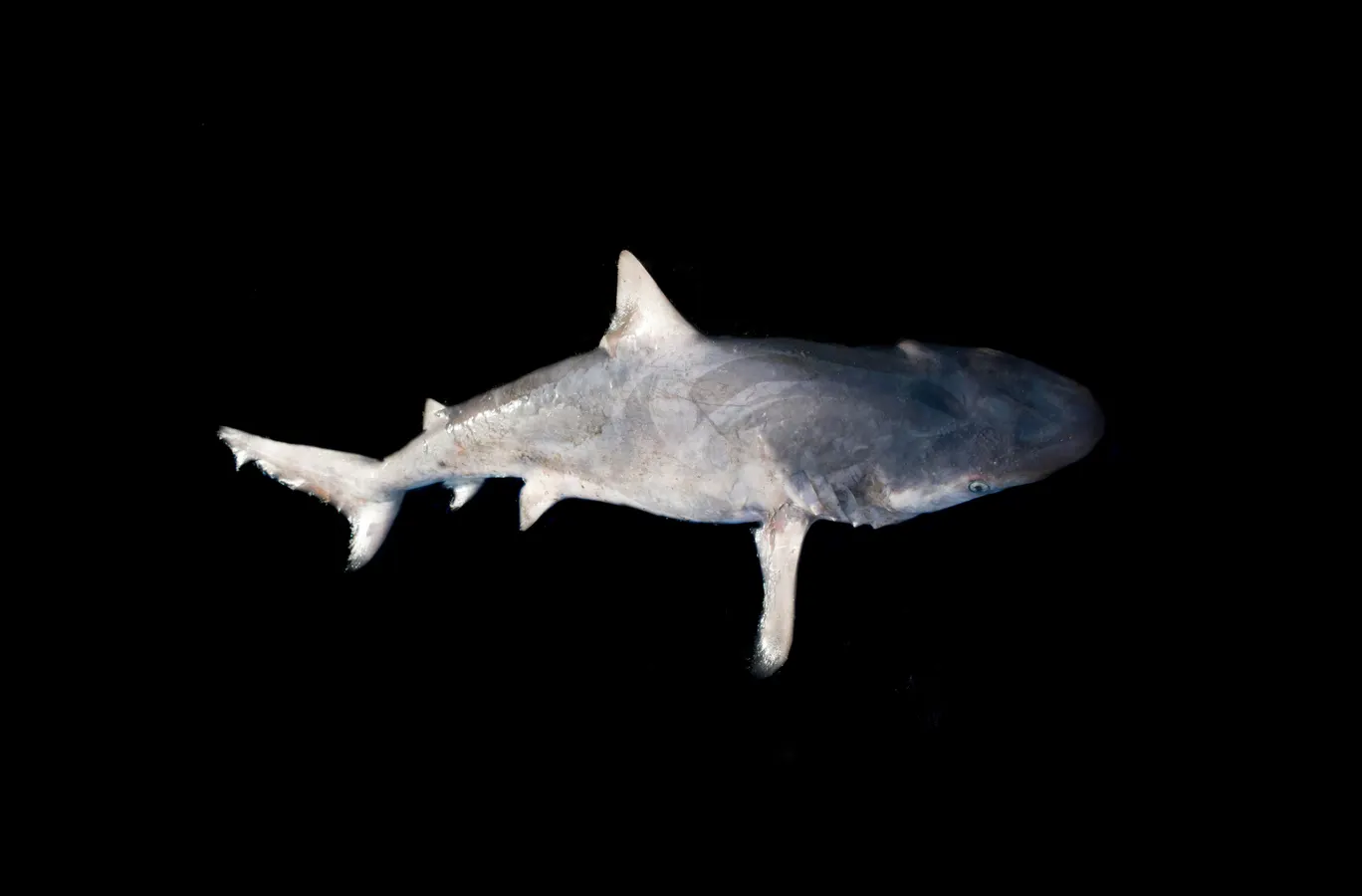
The spadenose shark (Scoliodon laticaudus) is one of the smallest members of the requiem shark family and found in shallow tropical and subtropical waters of the Indian and western Pacific Oceans.
The ocean feels endless — a boundless body of blue that stretches beyond the horizon, a world so vast it seems immune to human influence. Yet beneath that illusion of infinity, every crevice of it is slowly filling with human-made debris. Fragments of plastic smaller than a grain of rice, drift with the currents, slipping into the mouths of fish, turtles, seabirds, and sharks. These microplastics are everywhere, from tropical reefs to Arctic ice, and they carry with them the potential to disrupt life at every level. For sharks, already struggling against overfishing and habitat loss, this silent infiltration of their bodies represents a threat that is quietly undermining the resilience of a species that have survived for millions of years.
Sharks play a crucial role in ocean ecosystems, acting as top and meso-predators that help maintain balance in marine food webs. Their slow growth, late maturity, and low reproductive rates make them particularly vulnerable to exploitation. Over the past fifty years, populations of oceanic sharks and rays have declined by over 70 percent. Beyond overfishing (the main threat they face), pollution is emerging as a serious threat, with microplastics standing out as a global concern. Microplastics are tiny plastic fragments, less than five millimeters long, derived from the breakdown of larger plastics or manufactured at that size for commercial use; common polymers include polyethylene, polypropylene, polyvinyl chloride, and polystyrene. These particles have been detected across the world and within a wide range of marine life, including fish, seabirds, sea turtles, marine mammals, and even zooplankton. Their pervasiveness has made them one of the most concerning pollutants in marine ecosystems today. Studies have shown that microplastics can interfere with vital physiological functions in aquatic organisms, affecting respiration, growth, nutrition, reproduction, and survival. Experiments have demonstrated that these particles can move beyond the digestive tract, entering the bloodstream, crossing cell membranes, and eventually reaching reproductive organs. In mice, zebrafish, and oysters, microplastics have even been observed in gonads, suggesting they can bypass natural barriers and potentially impair reproductive health.
The impact that microplastics can have on an animal’s reproductive system are twofold: first, they can trigger inflammation and oxidative stress, upregulating cell death and proinflammatory molecules while downregulating proteins responsible for germ cell organization and steroid hormone production. Hormonal disruptions may also occur, reducing levels of testosterone, luteinizing hormone, follicle-stimulating hormone, and anti-mullerian hormone, ultimately reducing reproductive output. Secondly, microplastics can alter gene expression and interfere with gonadal regulatory proteins, compounding the threat to an individual’s reproductive health. Yet little is known about how this impacts sharks.
Tiny fragments of plastic, barely visible to the eye, are floating silently through our ocean, slipping into the bodies of fish, turtles, seabirds, and sharks. (Photo by LOUISA GOULIAMAKI / AFP) (Photo by LOUISA GOULIAMAKI/AFP via Getty Images)
AFP via Getty Images
It’s not that there isn’t evidence of plastic ingestion in sharks — there is. Research has documented plastics in a variety of sharks (such as whale sharks, basking sharks, manta rays, Atlantic sharpnose sharks, and a few demersal sharks to name a few) across different habitats. To understand how this dangerous pollution might impact sharks reproduction health, researchers focused on the spadenose shark (Scoliodon laticaudus), a small coastal carcharhinid common along the west coast of India. One of the smallest members of the requiem shark family (typically measuring around 3.9 to 4.9 feet or 1.2 to 1.5 meters), these sharks are found in shallow tropical and subtropical waters of the Indian and western Pacific Oceans, often inhabiting depths of 10–13 ft (3–4 m) near coastlines, estuaries, and coral reefs. Their abundance near shore, combined with their small size, makes them particularly vulnerable to bycatch, habitat degradation, and pollution. They are fast-growing and relatively short-lived compared to larger sharks, reaching sexual maturity within 1–2 years.
MORE FOR YOU
The study, led by researcher Haradhan Ruidas of the Indian Institute of Science Education and Research, Berhampur, assessed reproductive health using the gonadosomatic index (a metric that relates gonad weight to total body weight) to provide a consistent indicator of energy allocation to reproduction. As the team of scientists explained in their recent publication, variations in this index can reveal the influence of environmental stressors, disease, or pollutants. Their aim was to quantify microplastic accumulation in the gastrointestinal tract and gonads, examine its relationship with reproductive health in both sexes, and identify the types of plastic present using spectroscopy. Findings revealed microplastics in nearly all shark samples, with 97.9 percent of gastrointestinal tracts and 95 percent of gonads testing positive. Gonadal tissues showed the highest microplastic concentrations, with fibers comprising 85 percent of particles, followed by flakes and films. Female gonads contained significantly more microplastics than males, suggesting possible sex-specific translocation patterns. In male sharks, there was a negative correlation between microplastic concentration and gonadosomatic index (an indication that higher contamination may impair reproductive health). Spectroscopy was carried out, and it identified polyethylene and polyamide as dominant polymers along with other chemical contaminants.
That there exist microplastics in gonads is alarming, as it signals potential threats not just to individual reproductive success but to broader population recovery for the species as well. Sharks are slow to mature and produce relatively few offspring, so even small reductions in reproductive output can have ripple effects across populations. Over time, this can slow population growth, hinder recovery from overfishing, and destabilize the ecological roles that these predators play in marine food webs. In other words, microplastic contamination isn’t just a personal health issue for a single shark but a warning sign that the health of entire shark populations, and the balance of the ecosystems they help regulate, could be at risk. Understanding how pollutants like microplastics affect apex predators is essential because disruptions at this level could be catastrophic. Addressing plastic pollution at its source, monitoring contaminants in marine predators, and integrating pollution data into shark conservation strategies is critical.
Ultimately, the study reinforces what many of us in the conservation space already know: the effects of human-made pollution extend far beyond what we can see on the surface. Tiny threats, imperceptible to the naked eye, are quietly undermining the health and resilience of not just one of the most formidable predators on our planet (creatures, mind you, that have survived for hundreds of millions of years) but any and all animals. They all face a modern challenge that is entirely our making. Their future on our planet depends on our willingness to confront these unseen dangers before they tip the balance irreversibly. This is a test of how seriously we value the natural world… will we pass it?
Editorial StandardsReprints & Permissions



